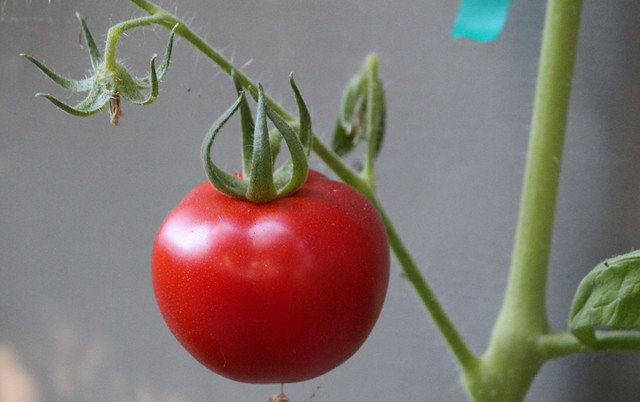 Save to Ideabook
Email Photo
Tomatoes
Save to Ideabook
Email Photo
TomatoesOne tasty tomato makes the three months’ growing season worthwhile, at least for me. The variety shown here is Early Girl, and I grew it in a partly shaded, 1-foot-wide space between the house and driveway — hardly a tomato paradise. I trained it up the wall with a small trellis and, as the vine grew taller, stretchy ties.
Choose from hundreds of tomato varieties. For small spaces consider compact types and indeterminates such as Early Girl. Avoid the big, spreading, determinate types unless you have plenty of space in your Gainesville landscape.
 Save to Ideabook
Email Photo
Basil
Save to Ideabook
Email Photo
BasilIt’s actually an herb, but with a good recipe for pesto sauce and some pasta, you can put together a pretty good-sized meal. Just a couple of plants will keep you supplied all summer with fresh basil leaves for snipping and tossing on sliced fresh tomatoes. I know the article is about only growing one edible, but maybe you can squeeze these two in your lawn? They make a great pair!
When and how to plant: Set out nursery seedlings when the weather warms in spring and summer.
Days to maturity: 60 to 90
Light requirement: Full sun, or partial shade in hot climates
Water requirement: Don’t let basil dry out — it’s sensitive to dryness.
Favorite varieties: Genovese is traditional. There are many other flavors, including Greek (Spicy Globe), Purpureum (Dark Opal) and Siam Queen (Thai).
Planting and care: Pinch to keep the plants bushy. Also remove flower stalks as they form.
Harvest: When the plants reach 6 inches or so tall, start snipping branch tips or pluck a few leaves.
See how to grow basil
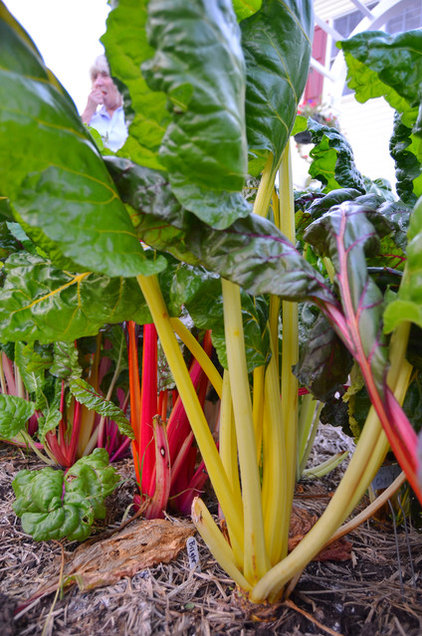 Amy Renea
Save to Ideabook
Email Photo
Chard
Amy Renea
Save to Ideabook
Email Photo
ChardThis is one of the most dependable and easiest vegetables you can grow, but most people don't know how to use it in the kitchen so they avoid it. Use the leaves when they’re young and tender as salad greens. Let them mature and use them for braising or steaming. Either way, it's a low maintenance Gainesville landscape edible is wonderful to eat.
When and how to plant: Sow seeds or set out seedlings in early spring; for a fall crop, sow seeds in late summer and fall. Sow seeds ½ inch deep, 2 inches apart; thin seedlings to about a foot apart. Space nursery seedlings accordingly.
Days to maturity: 60
Light requirement: Full sun, or partial shade in hot climates
Water requirement: Keep the soil fairly moist.
Favorite varieties: Fordhook Giant is a classic, although it tends to get large. Bright Lights and Rainbow add color.
Care: Stay on top of weeds. There are no particular pest problems.
Harvest: After a couple of months, you can pick mature leaves individually from the outside. Start harvesting tender, young leaves as small as several inches.
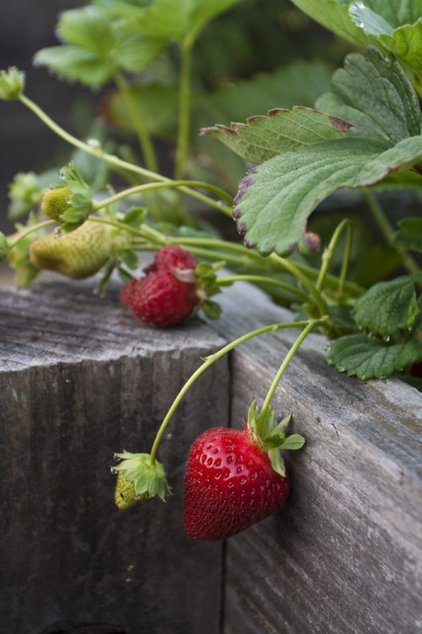 Shades Of Green Landscape Architecture
Save to Ideabook
Email Photo
Strawberry
Shades Of Green Landscape Architecture
Save to Ideabook
Email Photo
StrawberryNot a vegetable, of course, but often found in vegetable gardens, strawberries are just plain fun to grow. One taste of a deep red, fully ripe berry will tell you why. My all-time favorite variety is ‘Sequoia’, which bears a crop in June and July; it was developed for California but can be grown in USDA zones 5 to 8 (Gainesville is zone 8 for landscaping).
When and how to plant: In cold-winter climates, plant when the ground can be worked in early spring; in mild-winter climates, plant in winter or early spring; in warm-winter climates, plant in fall. Set out plants in rows or hills, or tuck a few into borders or containers.
Light requirement: Full sun or partial shade.
Water requirement: Water regularly. Don’t let the soil dry out.
Care: Watch for signs of disease and pests. You may need netting to protect the plants from marauding critters.
Harvest. Be patient if you want full flavor. Wait for a deep red color to develop, and then pick.
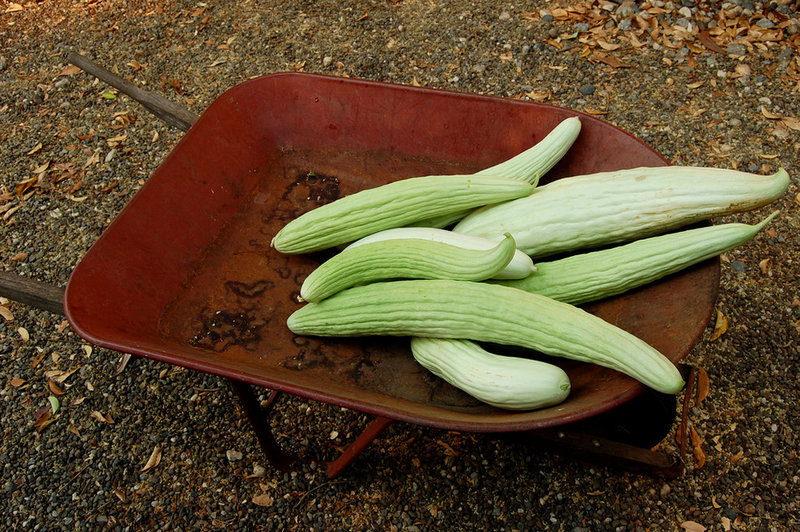 Calaveras KT
Save to Ideabook
Email Photo
Armenian Cucumber
Calaveras KT
Save to Ideabook
Email Photo
Armenian CucumberMy all-time favorite vegetable to grow for the fun of it, this heirloom cuke is supersize (up to 2 or 3 feet), often looks weirdly bent or even coiled, and has a crispness and mild flavor. You may have to shop around for seeds and seedlings because they aren't common in biig box locations. If you can't find it to plant in your Gainesville lawn, use another type of Cucumber that you enjoy the taste of.
When and how to plant: Wait until frosts are well past and the weather is warming. Treat it like any other cucumber. Bury the seeds ½ to 1 inch deep in a little hill-shaped mound; thin to keep two or three seedlings per hill.
Days to maturity: 65
Light requirement: Full sun
Care: Be prepared to stake or trellis the clambering, crawling vines.
Harvest: For best flavor pick when the cukes are about 15 inches long. Let them grow longer if you want a conversation piece.
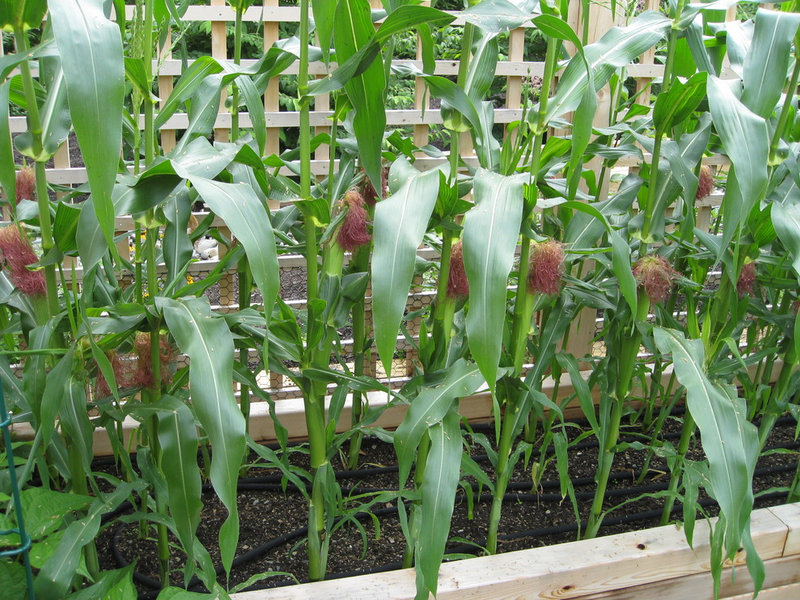 Land Design, Inc.
Save to Ideabook
Email Photo
Corn
Land Design, Inc.
Save to Ideabook
Email Photo
CornYes, growing corn takes space, but it’s such a great backyard lesson in botany (the tassels pollinate the kernels via the silks) and how dramatically better just-picked ears taste — let kids sample the sugary uncooked ears.
When and how to plant: To ensure pollination, plant the seeds in blocks, rows or a series of hills. Sow seeds 1 inch to 2 inches deep, 4 to 6 inches apart. When the seedlings are 6 inches tall, thin them to stand a foot apart. Make sure you prepare watering trenches or other irrigation methods in advance — corn is a water hog, and creating a watering system later is tough when the stalks have grown tall and dense.
Days to maturity: 55 and much longer, depending on variety
Light requirement: Full sun
Water requirement: Water regularly. Don’t let the soil dry out.
Favorite varieties: To save space look for compact varieties, especially those that are good in containers, such as Blue Jade and On Deck. Hint, hint: The word “midget” in a variety name is a pretty good clue that the variety is compact.
Harvest: About three weeks after the silks appear, the ears should be ready to harvest. Harvest them right before you plan to eat them.
We hope this has helped you enjoy the idea of adding edibles to your Gainesville lawn!
